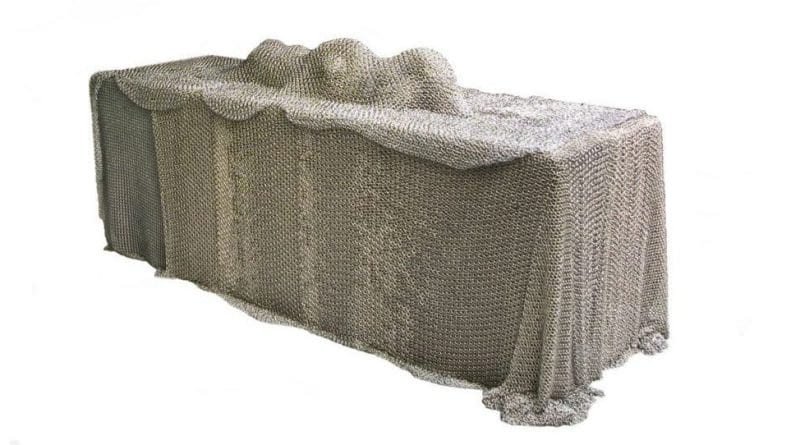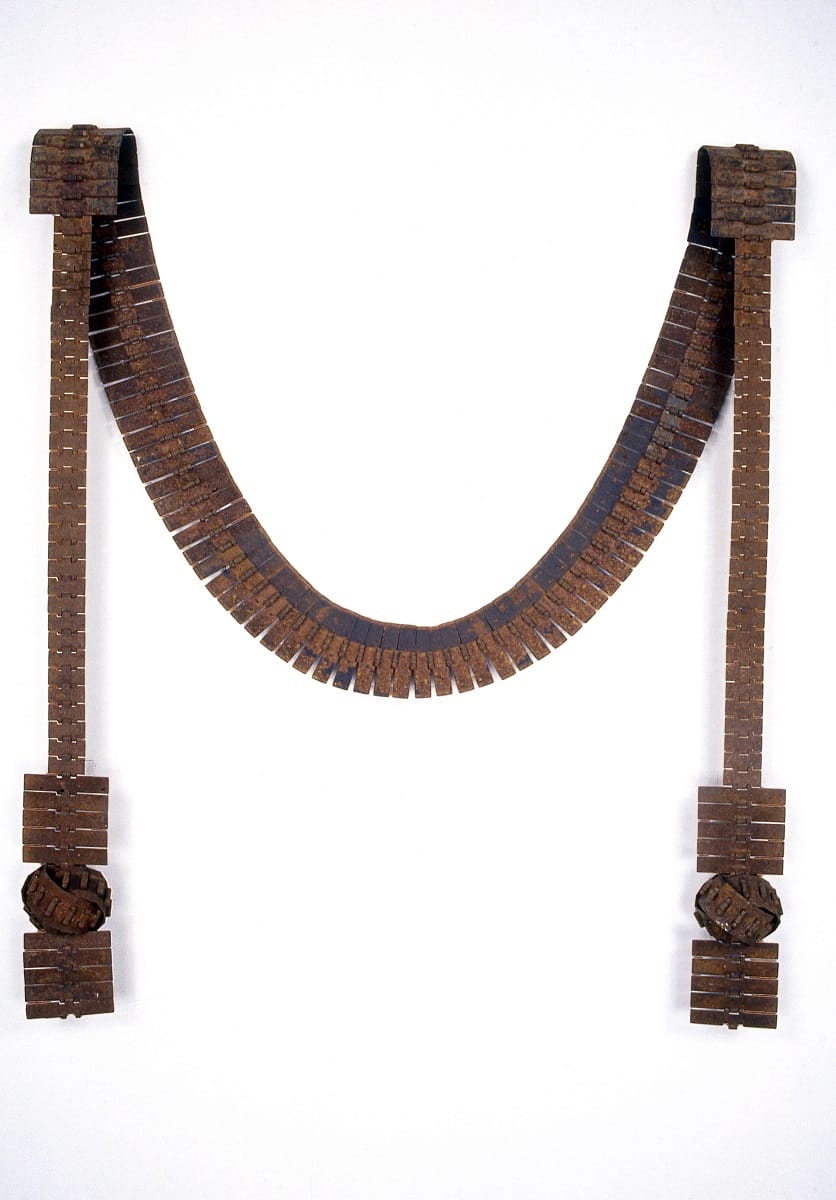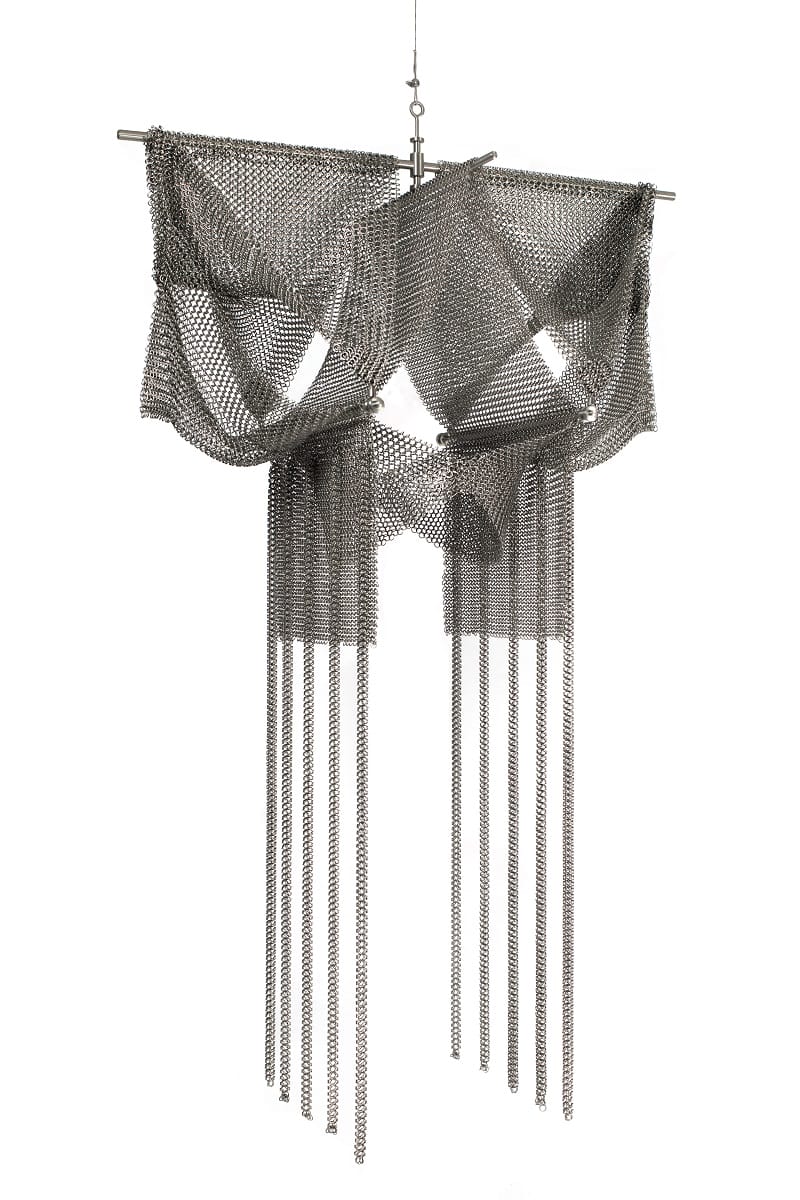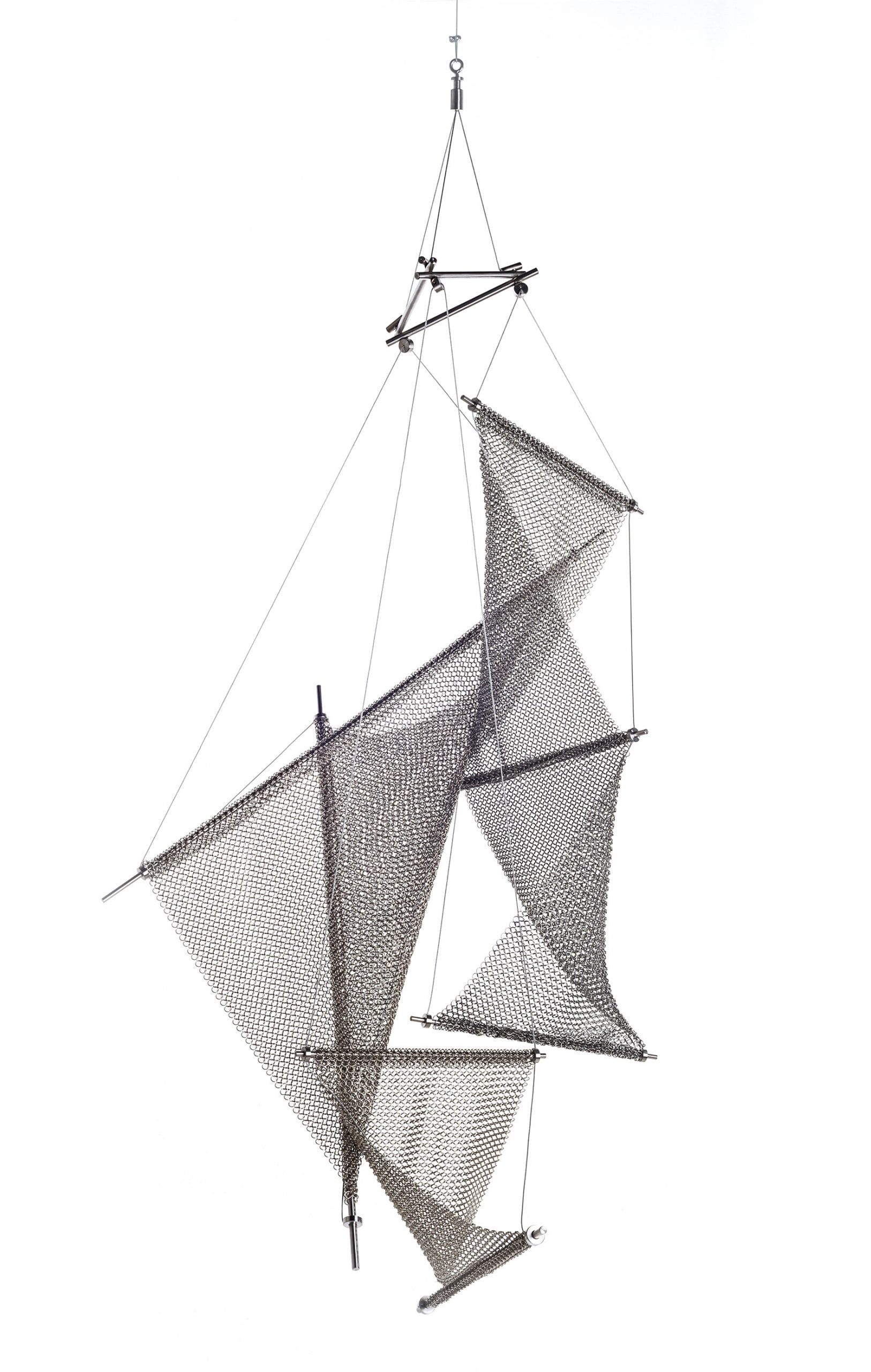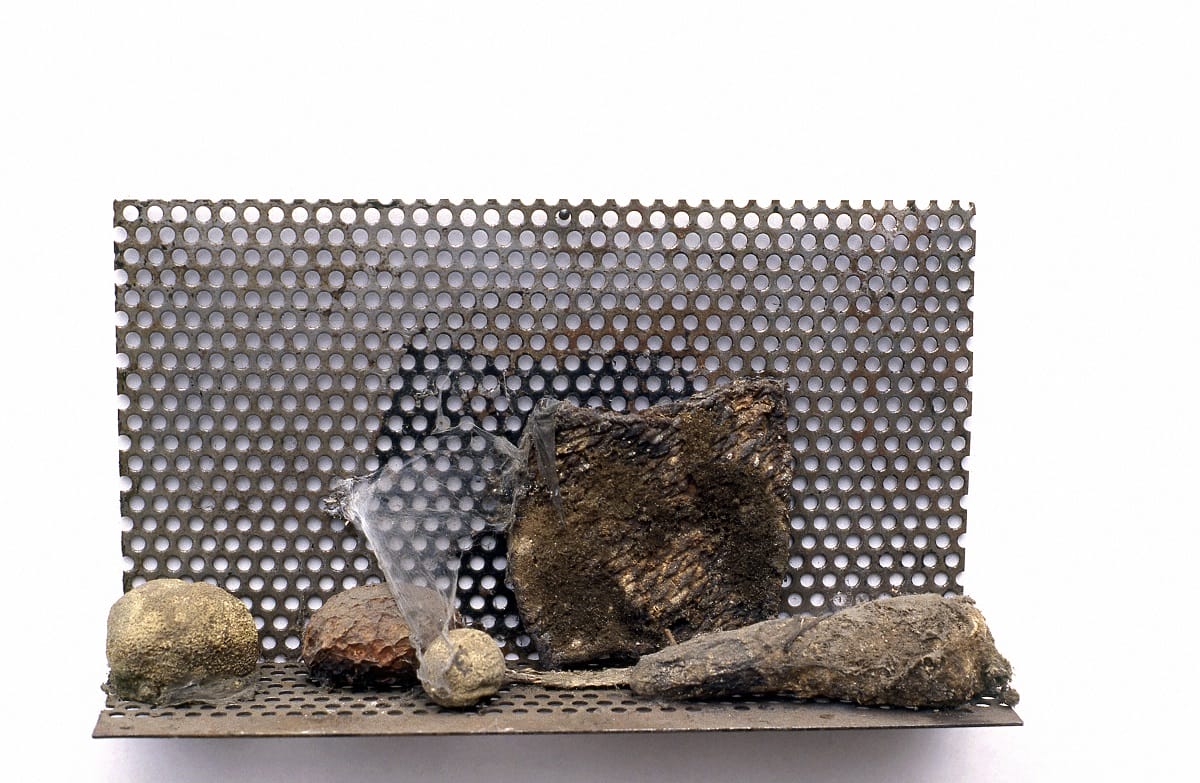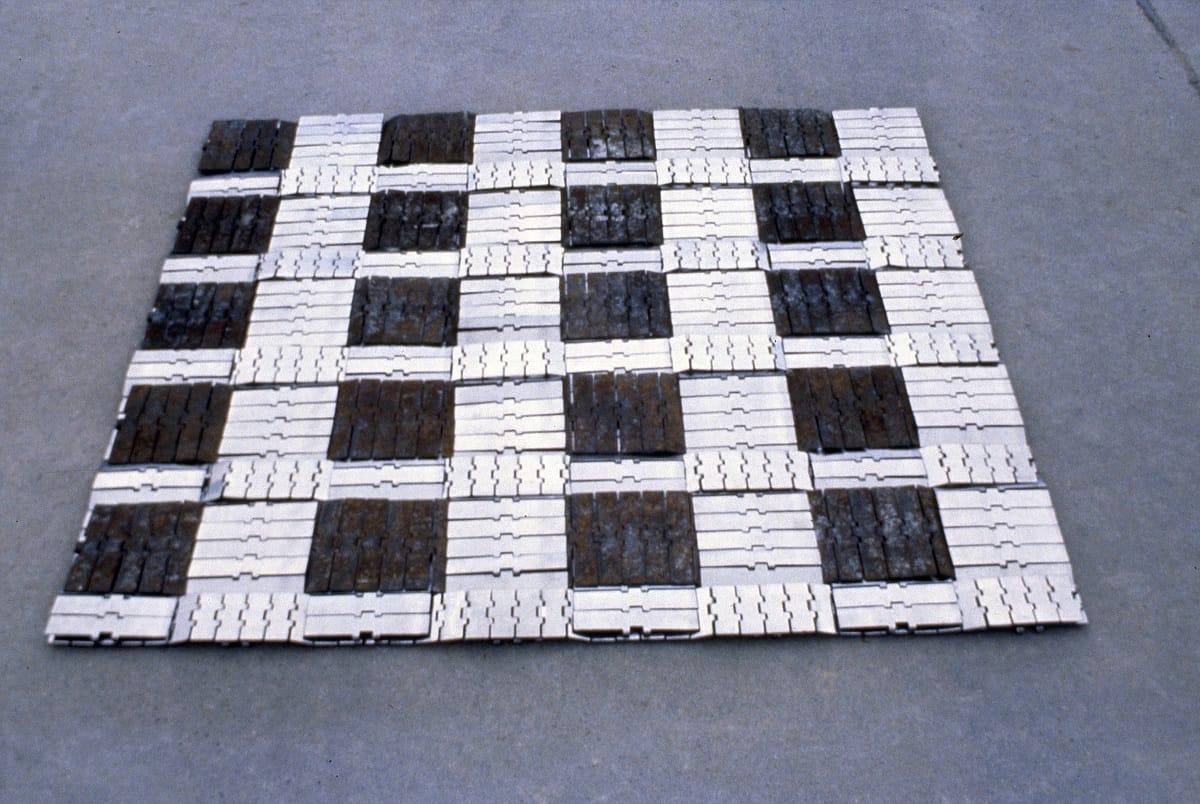Interview with Alvaro Diego Gomez Campuzano
Alvaro Diego Gomez Campuzano was born in Bogotà in 1956. In the same city, he graduated in Landscape architecture at Javeriana University in 1978. Since then, he has been working as an artist exhibiting his works in international exhibitions and public spaces worldwide.
I contacted him to speak about his recent New York show, which presents an extensive display of his textile works made before 1990. During the interview, he’s kindly shared information on his relationship with fibres and techniques, his sources of inspiration and how his artworks generate and evolve.
Ornamento Pectoral con Quipu, 1992. VII International Triennale of Tapestry Lodz, Poland
Industrial conveyor rusted band (200 x 165 x 22cm)
Alvaro, thread and fabric have been materials for your work since the 1970s. What led you to this choice?
I have ever considered textile as an artistic expression. Fabric is tied to the nature of a being, originating as it does in the lengthy process of collecting fruits and vegetable fibers which are then transformed into something magical that gives rise to a binary system of warp and weft. It is an experience whose immense and supportive sensitivity is to shelter human everyday life, to exalt beliefs, to tie relations with nature, and to signify in some way a personal and community transcendence through the gesture of creating, growing, integrating and representing.
The action of weaving is joining, assembling and constructing; thus, weaving is an excellent means of expression. The human body is tissue; the cosmos is an intertwining of universes and I have found an infinity of materials to intertwine, conferring meaning and direction to my work.
Anthropocene, 2018, Polyurethane, (20 x 20 x 15 cm)
Colombia has a tradition of textile art that has its roots in pre- Hispanic culture. Has this cultural heritage influenced your work and your research in the field of fiber art, and how?
Textiles are part of the prehistoric heritage and ancestral legacy of Latin America. Fabric arises with the first forms of human organization in cultures such as those of ancient Peru, Central America, North America, Africa, Asia and Oceania. I had the opportunity of visiting archaeological sites such as of Chichén-Itzá in Mexico, Machu Picchu in Peru and the Archaeological Park of San Agustín and Tierradentro in Colombia, finding inspiration in cultural references for my training as an artist, and, formally, discovering a fund of geometric, anthropomorphic and zoomorphic symbolism, which vestiges are reference to and give rise to my work. I have a keen interest in the numerical systems of Mesoamerican cultures, such as the pre-Inca and their accounting system, the Quipus; as well as the Mayans and their binary accounting systems (graphically similar by their points and lines to the representations of the first punched computer cards). I was also very interested in the hypothesis that the Muiscas had developed their accounting system called Guarismos Muiscas. I have investigated the symbolism of ancestral codes, such as petroglyphs, ideograms and pictograms, developing works that can be associated with totems of pre-Columbian ritual figures such as the works entitled “Frailejones”, “Ceremonial Canes” “Queros” and “Quipus”. Textile works speak volumes: they express cultural identity and transmit knowledge. They are a source of inspiration for art!
El Templo 2018. Stainless-steel chainmail, XXX Miniartextil Como, Italy, (210 x 105 x 56 cm)
Your textile works go beyond the two-dimensionality of the fabric by occupying three-dimensional space. This passage to the volumes of sculpture, when and why did it happen?
Since training as an architect in 1973, my foremost interest has been the overflow of textiles into space, where my works acquire aspects and planimetric proposals. These are aerial projects that float and evolve freely in space, an approach linked to the possibility of integration and a cooperation of textile arts with architecture in search of a total and enveloping joint environmental creation. Seeking to break traditional barriers in 1975, I created my first installation with variable dimensions entitled “Urban Landscapes”, composed of 12 hanging panels of cotton fabric with linear reliefs similar to pictograms (ranging in size from 250 x 140 cm to 400 x 140 cm.), positioned as a labyrinth for pedestrian circulation forming open and closed areas through which the viewer could walk.
Textile and architecture: how do you manage to make these two languages dialogue in your works?
Architecture has given me spatial and constructive references in regard to textiles. It has allowed me to intertwine concepts which have been wonderfully complementary in the development of my work, since everything woven or built is based on geometric parameters, with scales and measurements, based on proportions, structures, forces, moments of balance and tension according to the materials and their respective characteristics. I like to work in large or small-scale formats, applying these concepts to portable sculptures: Aerials, Spirals, Reflections -works in balance- suspended from the ceiling, with a support point made of natural and synthetic fibers, with tensors and force points in their turns and bends, which are almost always spiral or helical with iron counterweights so as to emphasize the verticality. These works are installed in interior spaces or in spatial intersections, creating vanishing points and relationships with architecture.
Mallas Urbanas, 2019, Stainless-steel chainmail
What are the themes at the center of your artistic research?
The main theme of my research is the relationship between man and his environment: architecture, the ancestral and the contemporary, the industrial and the technological. My work is a symbiosis of ancestral and contemporary codes linked to the concept of nature, which is tied to an archaeological and cosmogonic vision in which the elements that inhabit space have a symbolic connotation of opposing concepts, such as rituals and urban expressions, of organic and technological themes; of the natural and the industrial. I also incorporate in my textile work relationships with painting and sculpture. I have developed works where the concepts of lightness and heaviness, flexibility and rigidity are opposed. Since the 70s, with an ecological viewpoint I have reflected on environmental problems, which is why I have incorporated this contemplation of nature and pollution into my work.
In 2021 the Henrique Faria Fine Art proposed an exhibition of your textile works created over a period of twenty years, up to the 1990s. How has your work changed over time?
Between the 70s and 90s I worked with natural fibers, cotton, chlorophyll and earths as well as with synthetics like acrylic and polyurethane with which I developed techniques where the fabric proposes volume, structure and rigidity, applying tension, torsion and compression forces to the action of weaving.
Starting in the 90s, I researched organic works in biodegradation processes, investigating mold as a proposed textile in its conceptual content with the work “Still Life” created from some fruits suspended in time, on an oxidized and perforated sheet of iron. This work acquires poetic and aesthetic dimensions and also alludes to compositions seen through the History of Art, but in a three-dimensional, contemporary way. I also developed works with the skin or cellulose of the tomato, eggplant and red pepper, expressing them as a pictorial action and thus looking for opposed concepts from those that I had been researching as an alchemist.
Questing for references in traditional textiles, I began a process of contemporary urban archeology and made my first works of woven metal composed of recycled industrial conveyor belts such as chains, which I wove and assembled geometrically in opposition to the systems of ancient civilizations which that have their origin in the exploration of current computer-coding and urban life. Reusing the material and transforming its essence I made metal technically as flexible as textile.
Based on this new proposal I developed a series of works, among which is “Quipu”, which refers to the tracking system used by ancient civilizations and inspecting their accounting systems, which I presented in 1991 at the Negret Gallery in Bogotá, Colombia.
In 1992 I was invited for a second time to participate in the XV International Contemporary Textile Art Biennial in Lausanne – Switzerland with the work “Yupana Ornament”, of pre-Columbian and architectural connotations and which de-contextualizes the original codes of technique and material. In this same year I was invited to participate in the VII International Tapestry Triennial at the Central Museum of Textiles in Lodz – Poland, with the work “Pectoral Ornament with Quipu”, work of a ritual and industrial nature. For the Rio Group exhibition in 1992 at the Sofia Imber Museum in Caracas, Venezuela, I created “Frailejones”, “Tótems” and “Laguna”, all of which generate a ceremonial space associated with the ancestral, the mythical, the urban and nature.
During this time, and parallel to my sculpture work, I carried out an investigation using cave painting as a reference and developed a technique using iron cultures on synthetic surfaces by painting and scraping surfaces created in humid environments to produce chemical reactions which are subsequently fixed with lacquers, such as the work “Solar Explosions”. Towards the end of the millennium in the quarries of Bojacá, Colombia, I carved stone as an ancestral architectural dialogue linked to nature, “Sin Fin”, a 15-ton work composed of four rectangular stone monoliths installed in a circle, each stone facing a cardinal point, sculpture that is currently located on the campus of the Javeriana University in Bogotá, Colombia.
Bodegón 1998. Rotning fruits with spider web, (28 x 19 x 8 cm)
As a new proposal in 2000, I elaborated a medieval technique of weaving in chain mail, transforming it into reliefs with barcodes and computer programming cards. Concurrently, recreating ceremonial and ritual spaces as in the work “The Table is Served”, presented at XXV Miniartextil Como, Italy in 2015. This work represents the act of gathering as a community to celebrate and commemorate around a table from which the abstraction of a woman’s silhouette emerges among a landscape of mountain ranges evoking Pacha Mama, symbol of our origins. In 2019 I created “In Memoriam In Situ”, a tribute to the architectural heritage of the Cloister of Santo Domingo, in Cartagena Colombia. And more recently, three-dimensional aerial works such as “Temple” presented in XXX Mini Art Gallery Pinacoteca Museo Civico in Como, Italy in 2021. This work is made up of planes, shafts and vectors that intertwine in space representing a force that leads us to a portal unifying the sacred and the earthly, suggesting movement and transformation of energy. Works made with ancestral techniques in chainmail weaving allow us to travel through history, evoking memory and imagination linked to the universal symbolisms of ancestral cultures. In 2007 I was invited as a juror to the XIII International Tapestry Triennial at the Central Museum of Textiles in Lodz, Poland.
In 2010 I presented my lost wax bronze works, which are an abstraction and reflection on the Muisca Guarismos, research based on the hypothesis of historians such as Humboldt, who proposed the possible development of numerological systems by the Muiscas. Later, I did a residency in a fishing village called La Boquilla, Colombia, on the Caribbean Sea. I produced a ten-minute video titled “Atarraya” complemented by an installation, which recounts the life of the fishermen and the weaving of the fishing net.
Since the year 2000, I have incorporated plastic materials into my works using polyurethane injection with high-tech industrial machinery. In “Anthropocene”, exhibited at the XXVIII Miniartextil Como, Italy in 2018, where I explore the new human resulting from the transformation era of biotechnology and the interaction of man with the evolution of artificial intelligence, realizing that humans are the only species who can reason and adapt to adversity as resilient beings.
I see my work as a compendium of man, his prehistoric origins and his evolution. I have developed it by exploring a multiplicity of techniques, whose common thread is textile.
I have also been juror to the XIII International Tapestry Triennial at the Central Museum of Textiles in Lodz, Poland in 2007. I have participated in more than 100 group exhibitions and 14 individual exhibitions, including the XIII (1986) and XV (1992) Biennial of Lausanne, Switzerland; and have done ten exhibitions with Miniartextil in Como, Italy; VII (1992) Tapestry Triennial in Lodz, Poland; VI (1999) and VII (2002), the International Minitextile Triennial at the Museum of Fine Arts in Angers-France; IX (1992) Biennial of Minitextiles in Szombathely, Hungary.
Ornamento Yupana 1990, XV International Lausanne Biennial Switzerland
Industrial conveyor rusted and stainless-steel band (160 x 140 x 2 cm)
In the exhibition at Henrique Faria Fine Arts, for the first time since 1986 at the International Tapestry Biennial in Lausanne, there was “Interior Wall” one of your best-known works. Can you tell us about this work?
In 1986 I was invited to the XIII International Tapestry Biennial in Lausanne Switzerland with “Muro Interior”, an architectural work that included the representations of doors, windows, and stairs which I combined with dense and transparent areas. It is especially reminiscent of painting, not only for the fact that it depicts spaces in a frontal point of view, but because it represents and captures through the fabric a subjective interpretation of reality by means of geometric shapes, of everyday elements with marked lines and intercepted planes. This work was done in cotton, silk, wood and iron pulleys, materials which, when mixed, made possible a structure with depth of planes and great accuracy.
What are the new textile art projects on the horizon?
Contemporary textile art breaks boundaries and concepts thus fostering dialogue and collective reflection as a contribution to humanity. It is another way of approaching knowledge. As a result of technological developments applied to textiles, there is great innovation and new possibilities for materials and fibers creating a revolution in weaving.
I have projects aimed at researching and interacting with the textile industry and technology on these novel materials of greater resistance which react by way sensors to temperature, movement, sound, shape-shifting, color, textures, even transforming these into energy sources.
